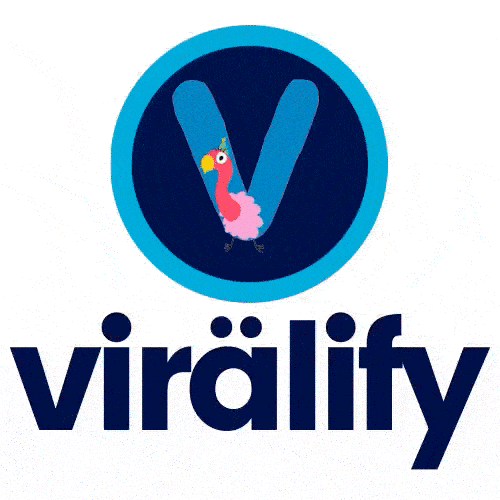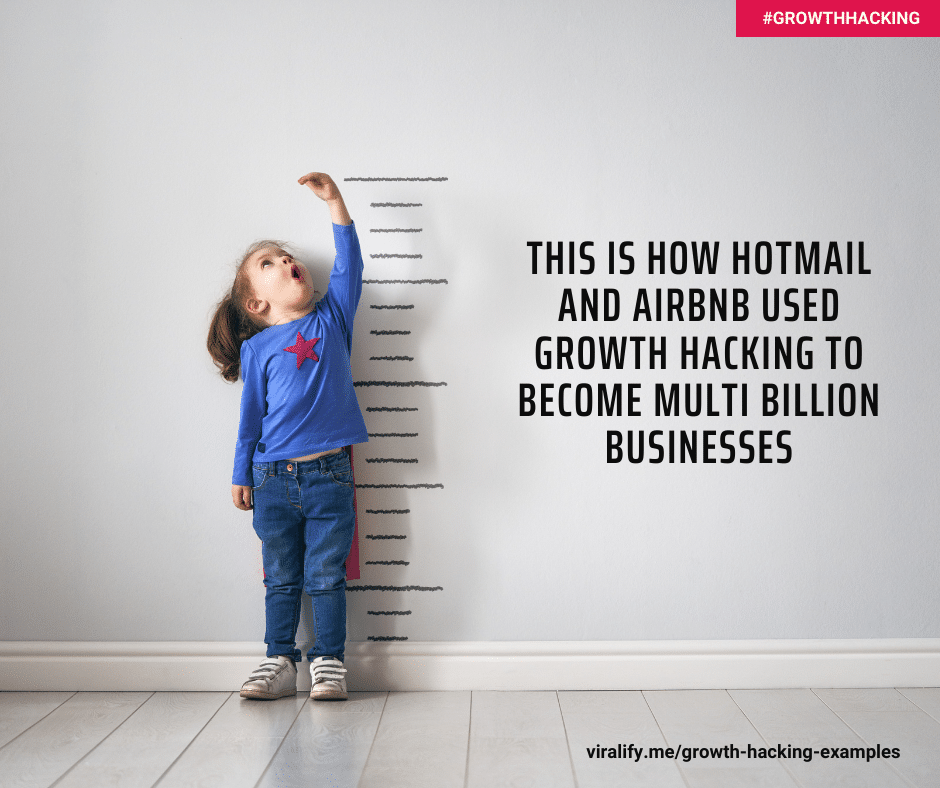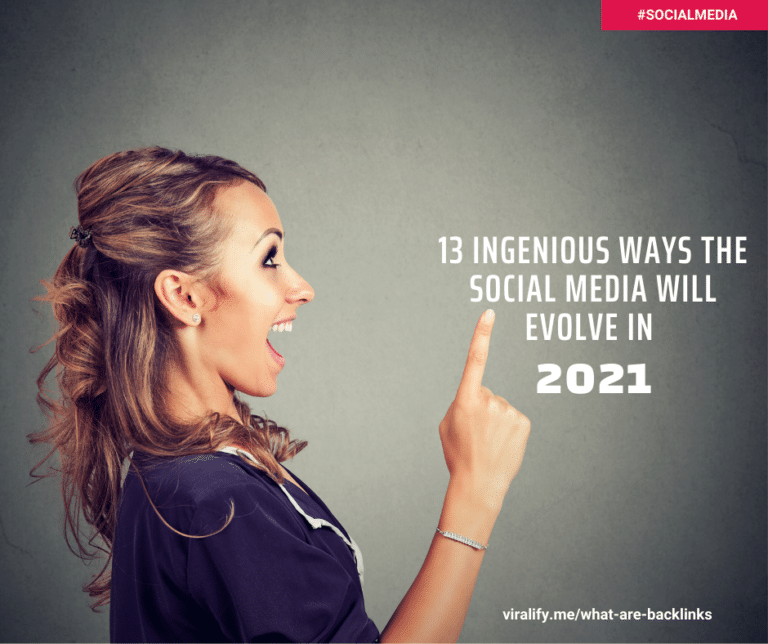In the era of start-ups, many failed to put out their prototypes or products to the market due to lack of funds or experience in marketing. Growth Hacking is a tool that start-ups can benefit from if they learn what Growth Hacking is and how to implement it.
What is Growth Hacking?
Growth hacking is experiment-driven marketing.It’s really about science. It’s about process. Growth hacking distinguishes itself from marketing for the reason that growth hacking involves science, data and process. Whereas traditional marketing promotes the products using main stream media channels in a belief that exposure brings more customers, growth hacking involves trying out different kind of tactics to expand the user base and finding out which channels and which methods outside of traditional marketing route works the best for which product and services that the startup is offering.
One of the main factor that differentiates growth hacking from the marketing is their objective. Growth hacking is a means for accelerated growth, but not the means for continuous growth and improvement. If the conventional marketing puts the focus on the general marketing strategy for the whole company, growth hacking puts the focus on the growth. Putting out the product to the right people, obtaining the user base and finding the right channels to communicate to the people is the key for growth.
The reason why growth hacking is not straightforward to many audiences is that it does not have one set guideline that works universally for all types of startups. Growth hacking must be done using creative minds in a scientific process that is scalable, measurable and repeatable. The “hack is to look for creative tricks that the startup can uniquely employ. Therefore, the methods for growth hacking differs depending on the target audience and the product of the startup.
Who are Growth Hackers?
A person who conducts growth hacking is called growth hacker. In simple terms,all the decisions that growth hacker makes must be approved by growth. One single goal that every growth hacker should have in mind is to obtain growth in the company and one of the valuable skill is the ability to execute it without permission or assistance. The decision-making is assisted by the results found in the experiments.
Each experiment employed by a growth hacker is one of the growth hacking tactics employed by the growth hacker in a certain span of time for example a week or month and by the end of the experiment, the data collected and logically analysed is the result that provide scientifically valuable information that growth hacker uses to make “true north is growth” decisions.
Growth hackers are a hybrid of marketer and coder, one who looks at the traditional question of “How do I get customers for my product?” and answers with A/B tests, landing pages, viral factor, email deliverability, and Open Graph.
If a startup is a preproduct/market fit, growth hackers can make sure virality is embedded at the core of a product. After product/market fit, they can help run up the score on what’s already working. One of the reasons that growth hacking started to get attention was the result of successful growth hacking tactics used by startups that grew to be an international-sized company.
Air BnB,s Growth hacking Strategy
Airbnb was the result of two designers unable to afford their rent and decided to offer their space to people who needed accommodation to the upcoming design conference in 2007. The response from the people was positive and the Airbnb founders, Brian Chesky and Joe Gebbia saw an opportunity to solve the problem in the existing market. In 2008 Airbnb was launched and now the company is valued at 25 billion USA dollars with 2 million listings in 57,000 cities and 192 countries.On average 500,000 stays occurs per night and the user base has grown to 60 million users.
One main reason for gaining the big number of users in a short period was the integration with the Craigslist in the beginning. Craigslist is a free platform where the users put the advertisements for their business, housings, jobs, for sales and personals. Craigslist was the perfect place to find the pool of people who had already put their places for rent. By e-mailing those people who have already put ads for renting out their places, Airbnb received a huge traffic to their site and converted the visitors into users .
Airbnb saw that their site was more user-friendly designed than Craigslist in terms of user interface and simplicity, however lacked the big user base that Craigslist had. Therefore, going after the users in Craigslist was the right solution for growth. This e-mail hack is simple and straightforward to many people but it is not easy to find the right channel to get the right people who will most likely to take an action and become a user.
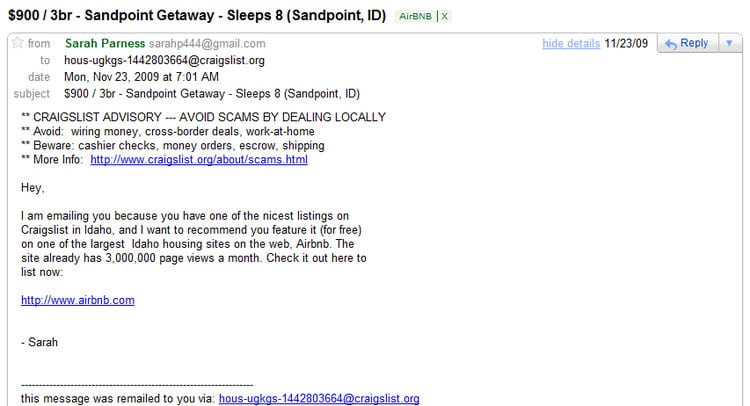
The important take away from this case is to find the right channel, place, platform where the target people is most concentrated at and find the most effective method to reach out to them. In addition, Airbnb did a reverse engineering where a new user registers they can use a tick-box option to post the listing to Craigslist automatically . It saves time and efforts of Airbnb users but increase the exposure level to gain more guests to rent out and to bring new users to Airbnb.
Airbnb steadily picked up the user base who are on the supply side, hosts that are providing accommodations to guests. However, the demand side, guests who pay for the accommodation service, showed weak numbers. The reason behind the weak demand was unknown so the founders, Gebbia and Chesky, investigated the cause of the problem. It turns out the listings were not visibly appealing to the guests which was the same problem Craigslist had. Without a good presentation, the product in this case, the listings, were not selling to the guests.
The founders tackled the problem by going door to door in New York listings and took professional photographs that would be more appealing to the guests. The result showed that the bookings in New York increased by two to three times. The experiment proved that having a high quality photographs on listings incurred higher bookings. With this learning, free photography service was launched in the summer of 2010 with twenty contracted professional photographers.
The growth was not an overnight scene but after a few months the growth was visibly noticeable in 2011.
Airbnb steadily picked up the user base who are on the supply side, hosts that are providing accommodations to guests. However, the demand side, guests who pay for the accommodation service, showed weak numbers. The reason behind the weak demand was unknown so the founders, Gebbia and Chesky, investigated the cause of the problem. It turns out the listings were not visibly appealing to the guests which was the same problem Craigslist had. Without a good presentation, the product in this case, the listings, were not selling to the guests.
The founders tackled the problem by going door to door in New York listings and took professional photographs that would be more appealing to the guests. The result showed that the bookings in New York increased by two to three times. The experiment proved that having a high quality photographs on listings incurred higher bookings.
With this learning, free photography service was launched in the summer of 2010 with twenty contracted professional photographers. The growth was not an overnight scene but after a few months the growth was visibly noticeable in 2011.
Hotmail,s Growth Hacking Strategy
Hotmail is the first free web-based email service and its growth hack is one of the earliest successful growth hacking method recorded. Hotmail was founded by Sabeer Bhatia and Jack Smith in 1996 in order to keep their private messages hidden from the boss. When the internet was introduced to the public, the email was not freely available and only a certain group of people were able to use the internet such as university students using university emails, employees using corporate emails and the last group which are of individuals using email services provided by Internet Service Provider, ISP. Even to these groups there were limitations and the use of email was not accessible from anywhere.

Hotmail’s free use of email service accessible from anywhere with the internet was solving the limitation and accessibility problem that the existing email services had. The only obstacle was to put it out to the public so people would sign up to use Hotmail. The idea of using billboards and radio ads was costly to the founders who just started Hotmail. Their investor had advised them to use catchy phrase with links as a signature at the end of every email that a Hotmail user sends.When the recipient clicks the link in the signature, it takes the user to the Hotmail landing page where the users are led to do the sign-ups seamlessly. The simple use of link led to a successful outcome as Hotmail hit its first 1 million user base within 6 months. This is how the communication went as explained to a Tech crunch reporter in “96.
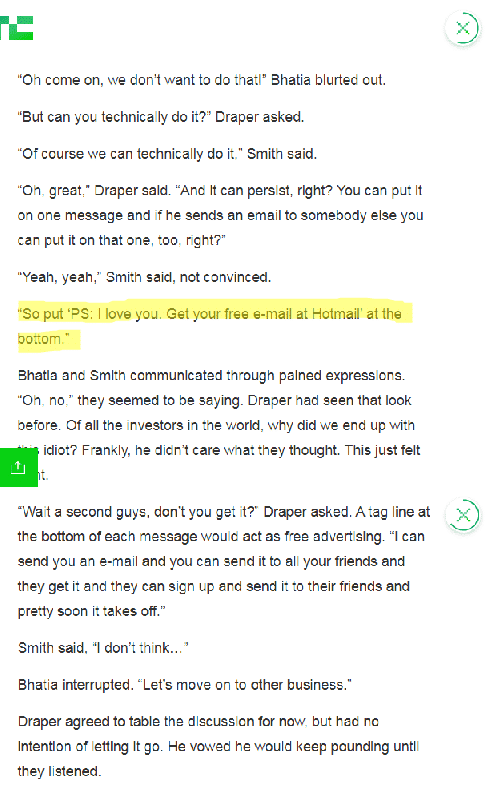
When one of the founder, Bhatia sent one email to a friend in India, 100,000 users signed up within 3 weeks of sending the email. The effect of using link in the signature was propounding, people trusted the email signature link as it came from their trusted family or friends and the price of the email service was free. This growth hack turned the emails sent out as advertisements and the Hotmail users into advocates.
1.5 years after its launch of the growth hacking method, Hotmail user base reach to 12 million and was sold to Microsoft for $400 million which is now known as MSN Hotmail. 12 million users are a significant number when the sum of internet users was only 70 million at that time. The growth hack was very simple to implement yet creative in a sense that the use of link in the signature has not been done before but it was extraordinarily successful because the product was solving the problem of using email services freely and the acquisition cost was near to none. The process of acquiring users was fast and seamless.
Growth hacking is a continual process with the dedication and commitment on constant experimentation, not a one-off trick or solution to get a boost on growth. Not all experiments will work as expected and that is the learning process; at least the company learns what does not work and does not waste time nor money on the same route again in the future. When one experiment has worked out of many, that idea becomes a part of the product or process becomes a part of the product.
Thinking of employing a growth hacking agency? Think Viralify – We hack growth better than anyone.
